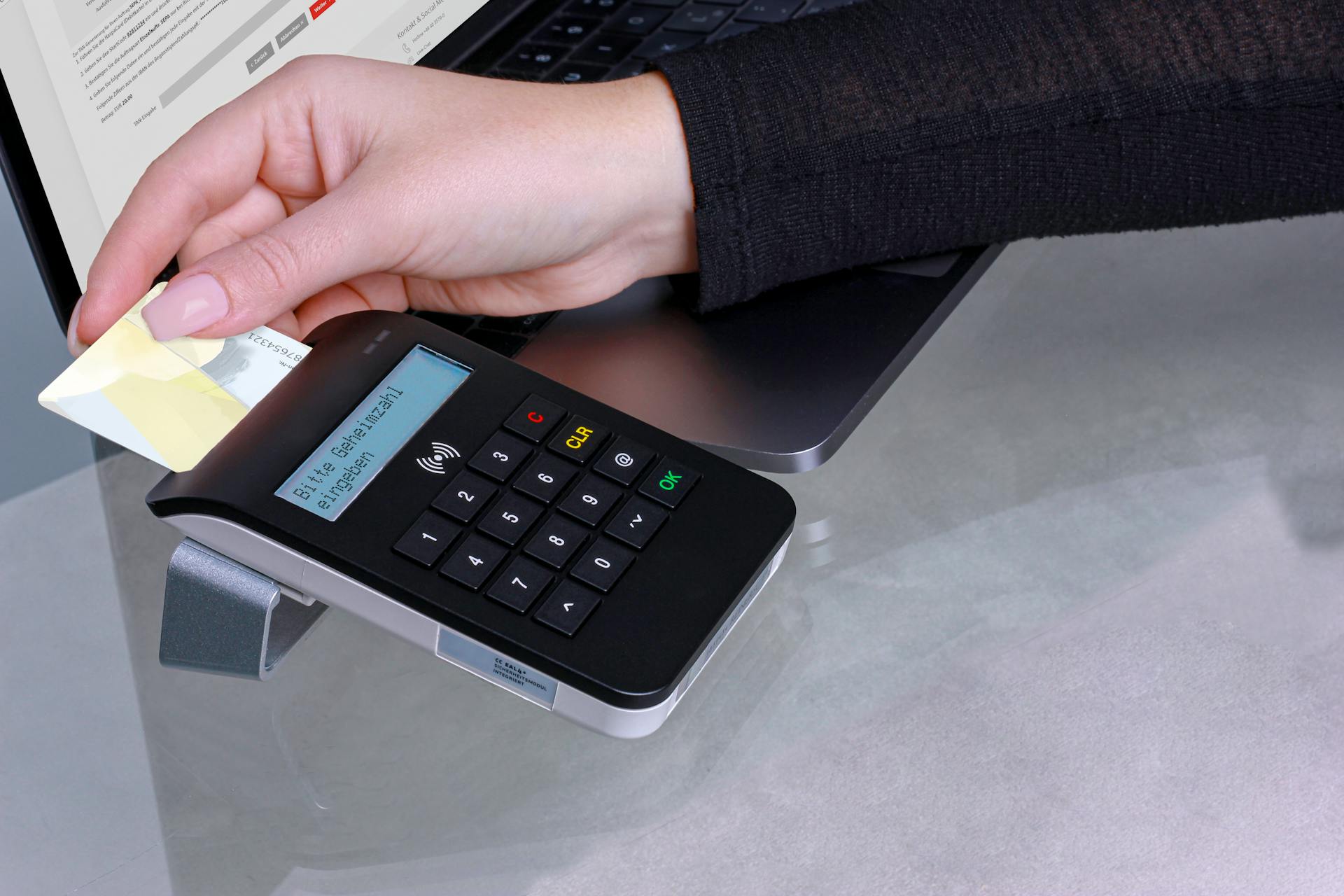
Electronic transactions for payment have become the norm in today's digital age, allowing us to make purchases, pay bills, and transfer funds with ease.
These transactions are processed through various channels, including online banking, mobile wallets, and credit card companies.
The Electronic Fund Transfer Act of 1978 regulates electronic transactions for payment, ensuring that consumers are protected from unauthorized transactions.
Electronic transactions for payment are also governed by the Payment Card Industry Data Security Standard (PCI DSS), which sets standards for secure payment processing.
What is an Electronic Transaction?
An electronic transaction is a transfer of value from one payment account to another using a digital device or channel. This can include payments made with bank transfers, mobile money, QR codes, and payment instruments like credit, debit, and prepaid cards.
Digital transactions can take various forms, such as being partially digital, primarily digital, or fully digital.
Defining
Digital payments are a crucial part of electronic transactions. A digital payment is the transfer of value from one payment account to another using a digital device or channel.
This can include bank transfers, mobile money, QR codes, and payment instruments like credit, debit, and prepaid cards. Digital payments can be made through various channels.
Digital payments can be partially digital, primarily digital, or fully digital. This means they can involve some physical elements, like cash or a physical card, but are largely facilitated by digital technology.
What Is a Transaction Set?
A transaction set is a security protocol that enhances online payment security and integrity, especially those involving debit and credit cards. It protects electronic payments by encrypting personal card details and authenticating users through digital certificates.
SET, or Secure Electronic Transaction, was developed in the late 1990s by Visa and Mastercard, in collaboration with several technology and Internet companies. This collaboration aimed to create a standard and universal protocol for securing online payments and promoting the growth of e-commerce.
A transaction set is not a payment system, but a security framework that can be linked with existing payment systems. It relies on the principles of Public Key Infrastructure (PKI).
Here are the four types of digital certificates used in SET:
- Cardholder certificates
- Merchant certificates
- Payment gateway certificates
- Authority certificates
These certificates are issued by trusted third parties and are used to establish a secure connection between the cardholder, the merchant, the payment gateway, and the card issuer.
Types of Electronic Transactions
Electronic transactions are a convenient and secure way to make payments. They're used for everything from online shopping to paying bills.
Card payments, such as those made with debit or credit cards, are a common form of electronic payment. Actual settlement between the bank and the merchant can take a few days, but the transaction appears immediately for the cardholder.
Online bank transfers allow individuals to move money directly from their bank accounts to another party's account. This method is often used for bill payments and peer-to-peer transactions.
There are several types of electronic transactions, including card payments, online bank transfers, electronic fund transfers, ACH transfers, wire transfers, and eChecks.
Card
Buying a book online and using your credit card to pay through a website with a padlock symbol in the address bar is an example of a secure electronic transaction.
Credit and debit cards have become ubiquitous in our daily lives, allowing us to make purchases by simply swiping our cards at the point of sale.
They are linked to our bank accounts, enabling us to spend within our financial means or borrow money (in the case of credit cards) for a limited period.
Virtual payment cards are digital versions of physical credit or debit cards, and can be used for online purchases without exposing your actual card details.
This is one of the common forms of electronic payment, where a customer uses a debit or credit card to pay for goods or services.
The transaction appears immediately for the cardholder, verifying that the transaction was successful, but actual settlement between the bank and the merchant can take a few days.
Card payments are linked to our bank accounts, enabling us to spend within our financial means or borrow money (in the case of credit cards) for a limited period.
Virtual payment cards enhance security and reduce the risk of fraud, making online shopping safer.
Recurring
Recurring transactions are a common type of electronic payment. They involve regular, repetitive transactions where a customer authorizes a vendor or service provider to deduct a specified amount from their account at predefined intervals.
Recurring payments are common for bills, subscriptions, memberships, or any service that requires periodic payments. This can include utility bills, gym memberships, and even rent payments.
A popular type of recurring payment is the eCheck, which is often used for rent payments. Property managers will often ask tenants to fill out a recurring eCheck rent payment form, which allows them to automatically deduct rent from their tenant's checking account on a certain day each month.
Recurring payments can be set up through various electronic payment systems, including online bank transfers and ACH transfers. These systems can automate repetitive tasks like invoicing, payment tracking, and reconciliation, freeing up finance teams to focus on more strategic work.
The eCheck clearing process varies slightly between providers, but generally, funds are verified within 24 to 48 hours of the transaction being initiated. If the payer has the funds available in their checking account, the transaction is typically cleared within three to five business days and the funds are moved to the payee's account.
Categorization
Categorization is a crucial aspect of electronic transactions. Electronic transactions can be broadly categorized into three types: online transactions, mobile transactions, and point-of-sale transactions.
Online transactions involve the transfer of funds through the internet, often using credit or debit cards. This type of transaction is commonly seen in e-commerce websites.
Mobile transactions, on the other hand, involve the transfer of funds using mobile devices. Mobile wallets and mobile banking apps are popular examples of mobile transactions.
Point-of-sale transactions occur when a customer makes a payment at a physical location, such as a store or restaurant. This type of transaction is often facilitated by a credit card terminal or a mobile payment device.
In the digital age, online transactions are increasingly becoming the norm.
Electronic Transaction Process
Electronic transactions are a convenient way to make payments, and understanding the process can help you navigate the process with ease.
Once a payment is approved, it's processed, and funds are transferred from the user's account to the merchant's account or the recipient's account.
The electronic transaction process can be broadly categorized into two main types: one-time payments and recurring payments. Each serves a unique purpose in facilitating transactions between customers and service providers or vendors.
Initiating an electronic payment involves providing the requested payment information, such as bank account details, a credit card number, or digital wallet credentials.
The payment gateway verifies the payment details, checking for available funds and other authorization factors like 2FA (two-factor authentication) before authorizing the transaction.
Here's a simplified overview of the electronic transaction process:
- Initiation: The customer initiates the payment by providing the requested payment information.
- Authorization: The payment gateway verifies the payment details, checking for available funds and other authorization factors like 2FA.
- Processing: Once the payment has been authorized, it's over to the payment processor to orchestrate the transfer of funds between the two parties' bank accounts.
- Settlement: After processing, the funds are settled, which means they are deducted from the payer's account or card and deposited to the receiver's account.
- Confirmation: Both the payer and the payee receive a notification and/or receipt of the successfully completed transaction.
In some cases, electronic transactions can be processed in real-time, thanks to platforms like RTP and FedNow, which facilitate instant transactions between businesses.
Security and Compliance
Security and Compliance is a top priority in electronic payment systems. Robust encryption and authentication measures protect sensitive financial data, reducing the risk of fraud and unauthorized transactions.
Electronic payment systems must maintain compliance with various regulatory frameworks, including PCI DSS, KYC and AML Regulations, and GDPR. These regulations require financial institutions and payment service providers to accurately verify the identity of users and monitor transactions for illicit activities.
To ensure security and compliance, it's essential to use trusted payment processors and secure payment gateways. This includes using SSL or TLS encryption, remaining compliant with PCI DSS guidelines, and enabling two-factor authentication. Advanced fraud detection tools that leverage AI and machine learning can also be used to enhance security and prevent fraud.
Here are some key regulatory frameworks that electronic payment systems must comply with:
- PCI DSS (Payment Card Industry Data Security Standard)
- KYC (Know Your Customer) and AML (Anti-Money Laundering) Regulations
- GDPR (General Data Protection Regulation)
Regular security audits and vulnerability assessments are also crucial to identify and address potential security risks.
Compliance with Regulations
Compliance with regulations is a crucial aspect of electronic payment systems. It's not just about following rules, but also about ensuring the security and integrity of financial transactions.
The Payment Card Industry Data Security Standard (PCI DSS) is a set of standards that all companies that process, store, or transmit credit card information must follow. This includes verifying the identity of customers and monitoring transactions for illicit activities.
KYC (Know Your Customer) and AML (Anti-Money Laundering) Regulations require financial institutions and payment service providers to accurately verify the identity of users and monitor transactions for suspicious activity.
The General Data Protection Regulation (GDPR) is a European data privacy law that mandates strict guidelines on how companies can collect, store, and process personal data.
Here are some of the key regulatory frameworks that electronic payment systems must comply with:
By following these regulatory frameworks, electronic payment systems can ensure the security and integrity of financial transactions, and protect sensitive customer information.
What Does It Mean to Be 'Responsible'?
To be responsible in digital payments, it means that transactions need to work every time, with effective recourse available if they fail.
This is crucial for digital payments to reach their full potential for people and economies. Effective recourse means that there should be a clear process in place to resolve issues when something goes wrong.
To ensure transparency, terms need to be clear and easy to understand, so users know what to expect. This way, users can make informed decisions about their digital payments.
Funds and data need to be protected, with accountability when this doesn't happen. This means that if something goes wrong, there should be consequences for those responsible.
Digital payments need to treat all people fairly, regardless of their background or circumstances. This means that everyone should have equal access to digital payment services.
To function effectively, digital payments need to work across different providers, allowing for competition and choice. This promotes innovation and better services for users.
Benefits and Advantages
Electronic transaction for payment offers numerous benefits and advantages that make it an attractive option for individuals and businesses alike. One of the key benefits is the reduction of transaction costs, as seen in examples 5 and 6, where eliminating physical cheques and cash handling can save individuals and businesses expenses related to printing, postage, and labor.
Digital payments also provide greater efficiency and speed, enabling faster and more accurate payments, as mentioned in example 7. This is particularly beneficial for individuals in rural or remote areas who can access government transfer programs without traveling long distances or waiting in lines.
In addition to cost savings and speed, electronic payments offer convenience, as highlighted in example 8. With electronic payments, individuals can shop online, pay bills, or split bills with friends with unparalleled ease and accessibility.
Some of the specific benefits of electronic payment systems include:
- Women’s economic participation by giving women more control over their financial lives and providing them greater economic opportunities.
- Inclusive growth by helping to unlock economic opportunity for the financially excluded and enabling a more efficient flow of resources in the economy.
- Transparency and security by enhancing payment traceability and accountability, and reducing corruption and theft.
- Financial inclusion by increasing access to a range of financial services, including savings accounts, credit, and insurance products.
- Cost savings by providing greater efficiency and speed.
- Climate resilience by helping vulnerable individuals and governments to mitigate and adapt to climate and disaster risks.
5 Benefits of Systems
Electronic payment systems have revolutionized the way we handle financial transactions, offering numerous benefits that make them a preferred choice for individuals and businesses alike. One of the key advantages of electronic payment systems is their speed, which ensures that funds are transferred quickly and accurately.
By eliminating the need for physical cheques and cash handling, electronic payment systems significantly reduce transaction costs for both individuals and businesses, with no expenses related to printing cheques, postage, or labor required to process paper payments.
Electronic payment systems also provide greater security, enhancing payment traceability and accountability, and reducing corruption and theft. This is achieved through advanced encryption and algorithm systems, as well as digital certificates that verify users and transactions.
In addition to security, electronic payment systems offer cost savings, providing greater efficiency and speed. For example, implementing treasury single accounts and digitizing revenue collection and payments can generate annual savings of USD1.1 billion for member countries.
The benefits of electronic payment systems are numerous, and they have been shown to have a positive impact on various aspects of society. For instance, digital payments can help unlock economic opportunity for the financially excluded, enabling a more efficient flow of resources in the economy.
Here are some key benefits of electronic payment systems:
Transaction Fees
Transaction fees are a crucial aspect of electronic payment systems. Some electronic payment systems charge transaction fees, which can accumulate over time.
These fees can add up quickly, so it's essential to understand what you're paying for. Transaction fees can range from $0.30 to $1.50 per eCheck transaction, depending on the provider of the eCheck merchant account.
Electronic payment systems can also charge varying fees, with some charging a higher per-transaction fee and a lower monthly fee, while others do the opposite. This can make a difference in your overall costs.
By being aware of these fees, you can make informed decisions about which electronic payment systems to use.
Frequently Asked Questions
What is meant by electronic mode of payment?
Electronic payment refers to online transactions made without cash or cheques, enabling instant money transfers between banks and financial institutions. This secure and convenient method is regulated by the RBI in India.
What is electronic payment summary?
Electronic payments are transactions completed through digital mediums, including credit and debit cards, ACH transfers, and virtual cards. This summary provides a brief overview of the concept of electronic payments.
Featured Images: pexels.com


